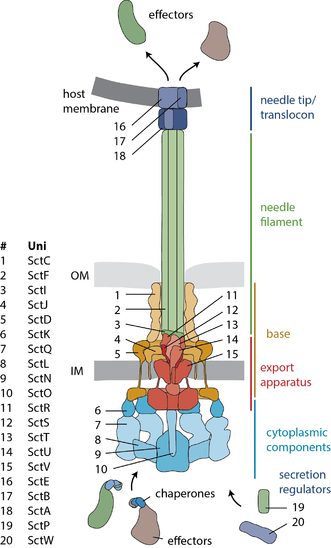Template:Main Page: Difference between revisions
Jump to navigation
Jump to search
No edit summary |
No edit summary |
||
| (One intermediate revision by the same user not shown) | |||
| Line 6: | Line 6: | ||
<div class="mainpage_box"> | <div class="mainpage_box"> | ||
<h3>General | <h3>General concepts</h3><hr> | ||
* [[Nomenclature of Type III Secretion Systems|Nomenclature]] | * [[Nomenclature of Type III Secretion Systems|Nomenclature]] | ||
* [[Flagellar T3SS vs. virulence-associated T3SS]] | * [[Flagellar T3SS vs. virulence-associated T3SS]] | ||
| Line 44: | Line 44: | ||
</div> | </div> | ||
<div class="mainpage_column flex3"> | |||
<div class="mainpage_box | <div class="mainpage_box"> | ||
<h3>Functional aspects</h3><hr> | <h3>Functional aspects</h3><hr> | ||
* [[Needle length control]] | * [[Needle length control]] | ||
| Line 51: | Line 51: | ||
* [[Host cell sensing]] | * [[Host cell sensing]] | ||
* [[Targeting of substrates]] | * [[Targeting of substrates]] | ||
</div> | |||
<div class="mainpage_box"> | |||
<h3>Applied and translational topics</h3><hr> | |||
* [[Biotechnological application of T3SS]] | |||
</div> | |||
</div> | </div> | ||
Latest revision as of 12:36, 20 September 2022
Virulence-associated type III secretion systems (T3SS) serve the injection of bacterial effector proteins into eukaryotic host cells to manifest bacterial colonization and infection. Consequently, these systems are essential factors for the virulence of numerous animal and plant pathogens like Salmonella, Yersinia, enteropathogenic Escherichia coli (EPEC) or Pseudomonas. The macromolecular machine mediating secretion and injection of effector proteins is called injectisome or needle complex. This wiki aims at providing a comprehensive overview of all aspects of T3SS.
Organisms hosting virulence-associated T3SS
Functional aspects
Components of the T3SS injectisome
| 1 | SctC | Secretin |
| 2 | SctF | Needle filament protein |
| 3 | SctI | Needle adapter (inner rod) protein |
| 4 | SctJ | Inner inner ring protein |
| 5 | SctD | Outer inner ring protein |
| 6 | SctK | Accessory cytosolic protein |
| 7 | SctQ | Major sorting platform component |
| 8 | SctL | Stator |
| 9 | SctN | ATPase |
| 10 | SctO | Stalk |
| 11 | SctR | Minor export apparatus protein |
| 12 | SctS | Minor export apparatus protein |
| 13 | SctT | Minor export apparatus protein |
| 14 | SctU | Switch protein |
| 15 | SctV | Major export apparatus protein |
| 16 | SctE | Translocon protein |
| 17 | SctB | Translocon protein |
| 18 | SctA | Needle tip protein |
| 19 | SctP | Needle length regulator |
| 20 | SctW | Gatekeeper |
